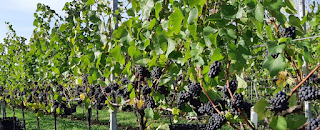Looking not too far into the future, what do we see for changes in the way grapes are grown and wine is made? Like other predictions, this is making assumption on current trends. There is always the unforeseen.
Automation / AI
In California, some grapes are machine picked, usually the ones that go into less expensive wines. Hand-picking is much more common with premium grapes. The acreage that are machine-picked vines will increase assuming manual labor costs keep increasing, while the machinery and software costs go down or stay level. However many vineyards aren't designed to allow machines to go up and down the rows. Plus, many winemakers don't believe the quality is there yet with machine-harvested grapes.
Sensors and drones will monitor vineyards for water needs and be on the lookout for various problems. That's handled now by someone walking up and down the rows looking for issues in the vineyard.
For example, in the cellar there are already optical scanners replacing manual sorting in some places.
 |
| Vineyard monitoring in coming and will check for soil temp, soil moisture, drip line leakage, and other issues image from Farmblox |
Going Green
- The Farming
There will be less Roundup (glyphosate) and more organic farming. Actually, it would be great if there is no Roundup. Consumers are requesting these changes, so winemakers are too. Organic farming, or at least farming without harsh chemicals like Roundup, is reasonably easy for grape growers. Even now, where it's used, there is far less of it sprayed than on food crops such as soybeans, corn, wheat, etc.
- The Wine
Organic wine making is a more complicated step most wine makers aren't willing to take, at least not yet. The biggest roadblock seems to be with sulfites that occur naturally in wine. Current U.S. law does not allow any to be added. This is a critical preservative in the wine making process. A better solution might be to allow the addition of sulfites in organic wine, but be sure the bottle is labeled with the ppm of sulfur dioxide. Perhaps even a rating system where below X ppm is low, a range over that is medium, and over a certain amount is considered high in sulfur dioxide to make it easy on the consumer.
Everybody loves organic, but organic wine can taste different and may have faults that wouldn't be there in a conventionally-made wine.
 |
| Benziger Vineyards in Sonoma County has been organic and biodynamic since before it was cool image from Benziger Vineyards |
Ingredient labeling
Alcoholic beverages don't require ingredient labeling, as does consumables under the FDA (alcohol is under the Treasury Dept). Related to the organic movement, you see more people asking for all ingredients in their wines be disclosed. A very few wineries are doing this now. With enough consumer and media push this could become a requirement.
 |
| Ingredient labeling |
Climate Change
Whether you believe in it or not, grape growers and winemakers are preparing for warmer weather.
- The Varieties
In the coming years we'll see new vineyards planted in what are considered cooler areas. In Sonoma County, Chardonnay and Pinot Noir will move closer to the coast. In California, warmer climate grapes like Vermentino, Sangiovese, and Barbera may become more popular. In Napa, Cabernet Sauvignon will be mostly in the cooler southern part of the county, like the new Coombsville appellation.
For a wine to be called by a varietal name in the U.S. it must contain at least 75% of that grape. So in the future Napa Cabernet may be blended with other grapes that not only work well with Cab, but are more heat tolerant. Charbono and Tempranillo are a couple examples.
In Bordeaux, new, heat tolerant grapes have been approved and will be showing up in future blends. One of these minor French grapes, Marselan, is known for it's dark color and tannins, something future Cabernet Sauvignon grapes will need if grown in a hotter climate. There's a bit of Marselan grown in California now, in Napa and Paso Robles, maybe other places. It may become more prevalent.
- The Vines
Other changes can be made in the vineyard so the grapes get less direct sun. This can be expensive because of the extra labor required. It will be very expensive if vines are pulled out and replaced with new ones that are a different variety and then are trained with different trellising. For example, a popular trellising system now for grape vines is Vertical Shoot Positioning (VSP) that was originally used for cool moist climates to give max sun and allow wind to dry out the clusters. As it turns out this is a bad idea for hot weather. Part of the reason for the higher alcohols in many California wine may be because of VSP trellised vines.
 |
| Vertical Shoot Position trellsing in the UK, where it makes sense Image from VineWorks |

No comments:
Post a Comment